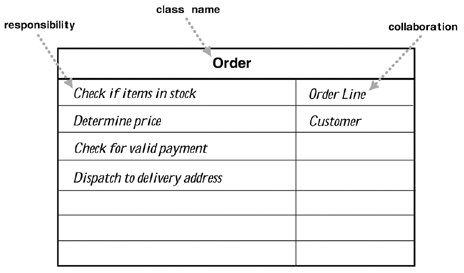|
One of the most valuable techniques in coming up with a good OO design is to explore object interactions, because it focuses on behavior rather than data. CRC (Class-Responsibility-Collaboration) diagrams, invented by Ward Cunningham in the late 1980s, have stood the test of time as a highly effective way to do this (Figure 4.6). Although they aren't part of the UML, they are a very popular technique among skilled object designers.

To use CRC cards, you and your colleagues gather around a table. Take various scenarios and act them out with the cards, picking them up in the air when they are active and moving them to suggest how they send messages to each other and pass them around. This technique is almost impossible to describe in a book yet is easily demonstrated; the best way to learn it is to have someone who has done it show it to you.
An important part of CRC thinking is identifying responsibilities. A responsibility is a short sentence that summarizes something that an object should do: an action the object performs, some knowledge the object maintains, or some important decisions the object makes. The idea is that you should be able to take any class and summarize it with a handful of responsibilities. Doing that can help you think more clearly about the design of your classes.
The second C refers to collaborators: the other classes that this class needs to work with. This gives you some idea of the links between classes梥till at a high level.
One of the chief benefits of CRC cards is that they encourage animated discussion among the developers. When you are working through a use case to see how classes will implement it, the interaction diagrams in this chapter can be slow to draw. Usually, you need to consider alternatives; with diagrams, the alternatives can take too long to draw and rub out. With CRC cards, you model the interaction by picking up the cards and moving them around. This allows you to quickly consider alternatives.
As you do this, you form ideas about responsibilities and write them on the cards. Thinking about responsibilities is important, because it gets you away from the notion of classes as dumb data holders and eases the team members toward understanding the higher-level behavior of each class. A responsibility may correspond to an operation, to an attribute, or, more likely, to an undetermined clump of attributes and operations.
A common mistake I see people make is generating long lists of low-level responsibilities. But doing so misses the point. The responsibilities should easily fit on one card. Ask yourself whether the class should be split or whether the responsibilities would be better stated by rolling them up into higher-level statements.
Many people stress the importance of role playing, whereby each person on the team plays the role of one or more classes. I've never seen Ward Cunningham do that, and I find that role playing gets in the way.
Books have been written on CRC, but I've found that they never really get to the heart of the technique. The original paper on CRC, written with Kent Beck, is [Beck and Cunningham]. To learn more about both CRC cards and responsibilities in design, take a look at [Wirfs-Brock].
|